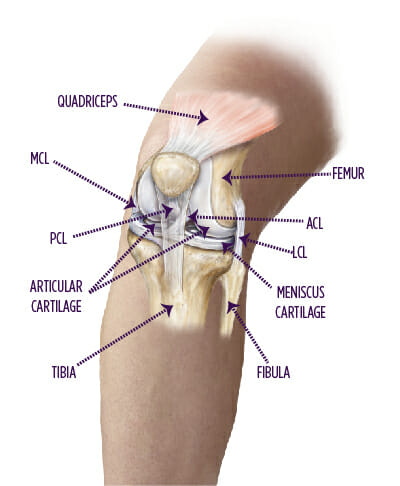What is a knee sprain?
A knee sprain is a stretching or tearing of one of the knee’s ligaments.
The knee is made up of a complex assortment of bones, ligaments, cartilage, and muscles. The three major bones of the knee are the thighbone (femur), the shinbone (tibia), and the kneecap (patella).
In addition to the bones and other structures, the knee is stabilized by ligaments. These ligaments act to prevent movement when the knee is forced beyond its normal range of motion. The main four ligaments of the knee are:
- The anterior cruciate ligament (ACL)
- The posterior cruciate ligament (PCL)
- The medial and lateral collateral ligaments (MCL and LCL)
When any one of these ligaments is damaged, it results in a knee sprain.
What causes a knee sprain?
Knee ligaments may be injured during athletic or occupational activities involving sudden force. Knee sprains may be caused by:
- Forced twisting of the knee
- Stopping suddenly while running
- Shifting your weight while running or skiing
- Landing awkwardly after jumping
- A blow to the outer or inner side of the knee
- A blow to the front of the knee while the knee is bent and the foot is firmly planted on the ground
What are the symptoms of a knee sprain?
Symptoms of a knee sprain depend on the location of the knee ligaments damaged and the damage’s severity. Some symptoms may include the following:
- Pain and swelling
- Tenderness
- Bruising
- Difficulty walking
How is a knee sprain diagnosed?
A discussion of your symptoms, a physical examination, and X-rays are useful for a diagnosis. Your specialist may recommend having an MRI as well.
How is a knee sprain treated?
Depending on the severity of your sprain, your physician may prescribe any of the following:
- Exercise
- Physical therapy
- Anti-inflammatory medications
- Cortisone injections
- Supportive braces
In cases that don’t respond to these treatments, surgery may be required.

